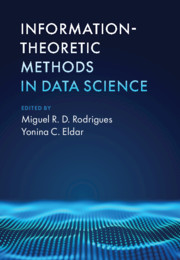Book contents
- Frontmatter
- Dedication
- Contents
- Preface
- Notation
- Contributors
- 1 Introduction to Information Theory and Data Science.
- 2 An Information-Theoretic Approach to Analog-to-Digital Compression
- 3 Compressed Sensing via Compression Codes
- 4 Information-Theoretic Bounds on Sketching
- 5 Sample Complexity Bounds for Dictionary Learning from Vector- and Tensor-Valued Data
- 6 Uncertainty Relations and Sparse Signal Recovery
- 7 Understanding Phase Transitions via Mutual Information and MMSE
- 8 Computing Choice: Learning Distributions over Permutations
- 9 Universal Clustering
- 10 Information-Theoretic Stability and Generalization
- 11 Information Bottleneck and Representation Learning
- 12 Fundamental Limits in Model Selection for Modern Data Analysis
- 13 Statistical Problems with Planted Structures: Information-Theoretical and Computational Limits
- 14 Distributed Statistical Inference with Compressed Data
- 15 Network Functional Compression
- 16 An Introductory Guide to Fano’s Inequality with Applications in Statistical Estimation
- Index
- References
6 - Uncertainty Relations and Sparse Signal Recovery
Published online by Cambridge University Press: 22 March 2021
- Frontmatter
- Dedication
- Contents
- Preface
- Notation
- Contributors
- 1 Introduction to Information Theory and Data Science.
- 2 An Information-Theoretic Approach to Analog-to-Digital Compression
- 3 Compressed Sensing via Compression Codes
- 4 Information-Theoretic Bounds on Sketching
- 5 Sample Complexity Bounds for Dictionary Learning from Vector- and Tensor-Valued Data
- 6 Uncertainty Relations and Sparse Signal Recovery
- 7 Understanding Phase Transitions via Mutual Information and MMSE
- 8 Computing Choice: Learning Distributions over Permutations
- 9 Universal Clustering
- 10 Information-Theoretic Stability and Generalization
- 11 Information Bottleneck and Representation Learning
- 12 Fundamental Limits in Model Selection for Modern Data Analysis
- 13 Statistical Problems with Planted Structures: Information-Theoretical and Computational Limits
- 14 Distributed Statistical Inference with Compressed Data
- 15 Network Functional Compression
- 16 An Introductory Guide to Fano’s Inequality with Applications in Statistical Estimation
- Index
- References
Summary
This chapter provides an introduction to uncertainty relations underlying sparse signal recovery. We start with the seminal work by Donoho and Stark (1989), which defines uncertainty relations as upper bounds on the operator norm of the band-limitation operator followed by the time-limitation operator, generalize this theory to arbitrary pairs of operators, and then develop, out of this generalization, the coherence-based uncertainty relations due to Elad and Bruckstein (2002), plus uncertainty relations in terms of concentration of the 1-norm or 2-norm. The theory is completed with set-theoretic uncertainty relations which lead to best possible recovery thresholds in terms of a general measure of parsimony, the Minkowski dimension. We also elaborate on the remarkable connection between uncertainty relations and the “large sieve,” a family of inequalities developed in analytic number theory. We show how uncertainty relations allow one to establish fundamental limits of practical signal recovery problems such as inpainting, declipping, super-resolution, and denoising of signals corrupted by impulse noise or narrowband interference.
Keywords
- Type
- Chapter
- Information
- Information-Theoretic Methods in Data Science , pp. 163 - 196Publisher: Cambridge University PressPrint publication year: 2021



